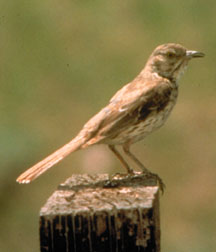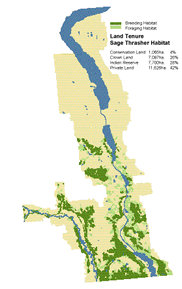|
Habitat Atlas for Wildlife at Risk
Sage Thrasher
Oreoscoptes montanus

Sage
Thrasher
|

- Length: 18 cm; slightly smaller than
American Robin.
- Brownish-grey back with buff white underparts,
heavily streaked with brown.
- Yellow eye, white tips on outer tail feathers
and two narrow white bars on wings.
- Small size, shorter tail, shorter bill and striped
breast distinguish it from other typical western
thrashers.
Status:
British Columbia Red List
Canada: Endangered
Special Significance
The Sage Thrasher is one of the rarest birds in Canada.
Prior to 1930, there were 30 or more nesting pairs
at up to six sites; in recent years, only 4 - 10
pairs have been seen at one or two sites. Over the
past 70 years, there has been an estimated 50 percent
loss of habitat for the Sage Thrasher. Heavy grazing
and clearing of sagebrush to improve range conditions
has seriously affected the availability of suitable
nesting areas. The preservation of remaining Sage
Thrashers depends on the careful management of remaining
large tracts of dense sagebrush habitat. Heavy grazing
of sagebrush sites should be avoided, and areas cleared
of sagebrush should be restored whenever possible.
Distribution
- In Canada, Sage Thrashers breed regularly only in the southern
Similkameen and Okanagan valleys, specifically in the White Lake
area and near
the Chopaka border crossing.
- Occasionally breeds in North Okanagan and Thompson
valleys (one record in each) as well as southern
Alberta and Saskatchewan.
- Elevational range is from near sea level to 950 metres;
breeds from 300 to 500 metres.
Habitat
- Sage Thrashers prefer large, open tracts of dry shrub/grassland
with dense stands of big sagebrush, antelope-brush and rabbit-brush.
- Stands of large sagebrush are required for both nesting
and foraging; shrubs need to be tall and sturdy
to support bulky nests and dense enough to provide shade and hiding
cover.
- Nests are bulky structures of coarse twigs, bark strips
and plant stems lined with fine grasses, horse
hair and fine rootlets.
Reproduction
- Can arrive in British Columbia as early as April or May, but there
is often a second influx in mid-June; males select
suitable sagebrush stands where they sing from the tops of tall
shrubs to attract females.
- Nesting starts from late May to late June.
- Females lay 4 or 5 eggs which are incubated by both
parents for about 15 days; eggs hatch from early
June to late July; young seen from mid-June to mid-August.
- Migrate south in late August or early September.
Food Habits
- Thrashers are omnivorous, eating mainly insects and berries.
Interesting Facts
- The Sage Thrasher nests almost exclusively in mature big sagebrush
environments.
- Sage Thrashers are known to build shade canopies from
sagebrush twigs over nests.
- The genus Oreoscoptes means "mimic of the mountains" and
refers to the Sage Thrasher's song.
- Birds prefer running to flying when searching for food.
Threats
- Loss of habitat due to agricultural and urban development.
- Burning and clearing of sage for range improvement.
- Heavy grazing may damage sagebrush and decrease
the native perennial grasses preferred by
thrashers.
- Susceptible to pesticides in insect prey.
Management Considerations
- Protect and maintain large tracts of fairly
dense sagebrush.
- Avoid clearing and burning of sagebrush for range
improvement.
- Monitor and reduce use of pesticides.
- Restore sagebrush to areas which have been cleared
in past.
- Avoid heavy grazing in sagebrush areas.
- Protect known breeding sites from human disturbance.
|
References
1. Blood, D.A. 1995. Sage Thrasher; Wildlife at Risk in British Columbia.
Brochure. Ministry of Water, Land and Air Protection, Victoria, British
Columbia
2. Cannings, R.J. 1995. Status of the Sage Thrasher
in British Columbia. Wildlife Branch, Ministry of Water, Land and
Air Protection Lands and Parks, Victoria, British Columbia
3. Campbell, R.W., N.K. Dawe, I. McTaggart-Cowan, J.
Cooper, G. Kaiser and M.C. McNall. 1997. Birds of British Columbia:
Volume 3. University of British Columbia Press, Vancouver, BC.
4. Cannings, R.A., R.J. Cannings and S.G. Cannings.
1987. Birds of the Okanagan Valley, British Columbia. Royal British
Columbia Museum, Victoria, BC.
|